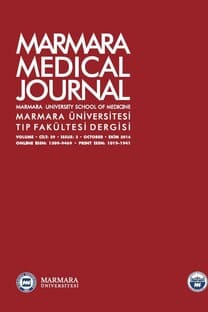Rapid voluntary clench induces bite force reflex in human
İnsanda hızlı istemli diş sıkma, ısırma refleksi meydana getirir
___
- 1. türker Ks. Reflex control of human jaw muscles. Crit Rev Oral biol Med 2002; 13: 85-104.
- 2. trulsson M. sensory-motor function of human periodontal mechanoreceptors. J Oral Rehabil 2006; 33: 262-73. doi: 10.1111/j.1365-2842.2006.01629.x.
- 3. lambrichts i, Creemers J, van steenberghe D. Morphology of neural endings in the human periodontal ligament: an electron microscopic study. J Periodontal Res 1992; 27: 191-6.
- 4. Uginčius P, atiş Es, türker Ks. Reflex responses of human masseter motor units to mechanical stimulation of the teeth. J neurophysiol 2014; 111: 51-61. doi: 10.1152/jn.00478.2013.
- 5. lund JP. Mastication and its control by the brain stem. Crit Rew Oral biol Med 1991; 2: 33-64. doi: 10.1177/10454411910020010401.
- 6. Meier-Ewert K, gleitsmann K, Reiter F. acoustic jaw reflex in man: its relationship to other brain-stem and microreflexes. Electroencephalogr Clin neurophysiol 1974; 36: 629-37.
- 7. Yang J, türker Ks. Jaw reflexes evoked by mechanical stimulation of teeth in humans. J neurophysiol 1999; 81: 2156- 63.
- 8. brodin P, türker Ks, Miles ts. Mechanoreceptors around the tooth evoke inhibitory and excitatory reflexes in the human masseter muscle. J Physiol 1993; 464: 711-23. doi: 10.1113/ jphysiol.1993.sp019659.
- 9. türker Ks, sowman PF, tuncer M, tucker KJ, brinkworth Rsa. the role of periodontal mechanoreceptors in mastication. arch Oral biol 2007; 52: 361-4. doi:10.1016/j. archoralbio.2006.11.014.
- 10. thomas nR, Peyton sC. Relationship of masseter electromyographic activity to mandible position in the freely- moving rat. arch Oral biol 1983; 28: 1043-6.
- 11. ahlgren J. the silent period in the EMg of the jaw muscles during mastication and its relationship to tooth contact. acts Odontol scand 1969; 27: 219-27.
- 12. sessle bJ, schmitt a. Effects of controlled tooth stimulation of jaw muscle activity in man. arch Oral biol 1972; 17: 1597- 607.
- 13. türker Ks, Jenkins M. Reflex responses induced by tooth unloading. J neurophysiol 2000; 84: 1088-92.
- 14. besset RW, Mohl nD, bishop b. Contribution of periodontal receptors to the masseteric silent period. J Dent Res 1976; 53: 1196-203.
- 15. Moxham bJ, berkovitz bKb. the effects of external forces on the periodontal ligament. in: berkovitz bKb, editor. the Periodontal ligament in Health and Disease. 2nd ed. london: Mosby-Wolfe, 1995: 215-41.
- 16. brinkworth Rsa, türker Ks. a method for quantifying reflex responses from intra-muscular and surface electromyogram. J neurosci Methods 2003; 122: 179-93. doi:10.1016/s0165- 0270(02)00321-7.
- 17. brinkworth Rsa, türker Ks, savundra aW. Response of human jaw muscles to axial stimulation of the incisor. J Physiol 2003; 547: 233-45. doi: 10.1111/j..2002.00233.x.
- 18. Hannam ag. Changes in the activity of the masseter muscle following tooth contact in man. arch Oral biol 1969; 14: 1401- 6.
- 19. Mason ag, scott bJ, van der glas HW, linden RW, Cadden sW. Remote noxious stimuli modulate jaw reflexes evoked by activation of periodontal ligament mechanoreceptors in man. Exp Physiol 2002; 87: 699-706. doi: 10.1113/eph8702452.
- 20. Yu sKJ, schmitt a, sessle bJ. inhibitory effects on jaw muscle activity of innocuous and noxious stimulation of facial and intraoral sites in man. arch Oral biol 1973; 18: 861-70. doi: doi:10.1016/0003-9969(73)90056-3.
- 21. brinkworth Rsa, türker Ks. EMg, force and discharge rate analysis of human jaw reflexes in response to axial stimulation of the incisor. Exp brain Res 2005; 161: 145-54. doi: 10.1007/ s00221-004-2053-4.
- 22. garcia Cartagena a, gonzalez sequeros O, Carrido garcia vC. analysis of two methods for occlusal contact registration with the t-scan system. J Oral Rehab 1997; 24: 426-32. doi: 10.1111/1365-2842.ep14748221.
- 23. Kohyama K, Hatakeyama E, sasaki t, azuma t, Karita K. Effect of sample thickness on bite force studied with a multiple-point sheet sensor. J Oral Rehab 2004; 31: 327-34. doi: 10.1046/j.1365-2842.2003.01248.x.
- 24. trulsson M. Force encoding by human periodontal mechanoreceptors during mastication. arch Oral biol 2007; 52: 357-60. doi: 10.1016/j.archoralbio.2006.09.011.
- 25. Kawamura Y. Recent concepts of the physiology of mastication. in: staple PH, editor. advances in Oral biology. vol. 1. london: academic Press, 1964: 77-109.
- ISSN: 1019-1941
- Yayın Aralığı: 3
- Başlangıç: 1988
- Yayıncı: Marmara Üniversitesi
Tıp Eğitiminde sanal hasta kullanımı
Suheyla TOPRAK, Selen EVİRGEN, Hilal İLBARS
Early-onset neurolupus: A challenge for pediatricians
Safa BARIŞ, Elif AYDINER KARAKOÇ, Ahmet ÖZEN, Melissa KAÇMAZ, Medya NAMAR, Nurdan YILDIZ, Dilşat TÜRKDOĞAN, Işıl BARLAN
Suat BİÇER, Gülay ERDAĞ ÇİLER, Canan YILDIRIM KOCAMAN, Tuba GİRAY, Defne ÇÖL, Öznur KÜÇÜK, Zerrin YALVAÇ, Ayça VİTRİNEL
Comparison of histopathological characteristics and clinical behavior of acquired cholesteatoma
Mahmood SHISHEGAR, Mohammad Javad ASHRAF
The olfactory reference syndrome treated with escitalopram: A case report
Özlem Devrim BALABAN, Gizem BOZ, Kumru ŞENYAŞAR, Menekse Sila YAZAR, ALİ KEYVAN, Nezih ERADAMLAR
